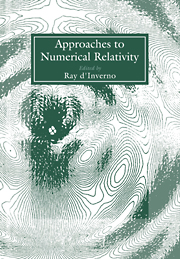Book contents
- Frontmatter
- Contents
- Contributors
- Introduction
- Preface
- PART A THEORETICAL APPROACHES
- Numerical relativity on a transputer array
- Some aspects of the characteristic initial value problem in numerical relativity
- The characteristic initial value problem in general relativity
- Algebraic approach to the characteristic initial value problem in general relativity
- On hyperboloidal hypersurfaces
- The initial value problem on null cones
- Introduction to dual-null dynamics
- On colliding plane wave space-times
- Boundary conditions for the momentum constraint
- On the choice of matter model in general relativity
- A mathematical approach to numerical relativity
- Making sense of the effects of rotation in general relativity
- Stability of charged boson stars and catastrophe theory
- PART B PRACTICAL APPROACHES
- PANEL DISCUSSION
The initial value problem on null cones
Published online by Cambridge University Press: 15 December 2009
- Frontmatter
- Contents
- Contributors
- Introduction
- Preface
- PART A THEORETICAL APPROACHES
- Numerical relativity on a transputer array
- Some aspects of the characteristic initial value problem in numerical relativity
- The characteristic initial value problem in general relativity
- Algebraic approach to the characteristic initial value problem in general relativity
- On hyperboloidal hypersurfaces
- The initial value problem on null cones
- Introduction to dual-null dynamics
- On colliding plane wave space-times
- Boundary conditions for the momentum constraint
- On the choice of matter model in general relativity
- A mathematical approach to numerical relativity
- Making sense of the effects of rotation in general relativity
- Stability of charged boson stars and catastrophe theory
- PART B PRACTICAL APPROACHES
- PANEL DISCUSSION
Summary
Abstract. The characteristic initial value problem is reviewed and a number of possible schemes for implementing it are discussed. Particular attention is given to choosing variables and choosing a minimal set of equations in the Newman–Penrose formalism. A particular scheme which is based on null cones and involves giving the free gravitational data in terms of Ψ0 is presented. The question of regularity at the vertex is briefly discussed and asymptotic expansions for the spin coefficients near the vertex are given.
INTRODUCTION
In studying problems in which gravitational radiation plays an important rôle, a description of the geometry which is adapted to the wavefronts of the radiation is obviously useful. Thus both the Bondi formalism and Newman–Penrose formalism have proved very helpful in understanding gravitational radiation at null infinity J+. From the point of view of an initial value problem this suggests that rather than specifying data on a spacelike surface one should specify data on a null surface and look instead at the characteristic initial value problem (CIVP).
There are a number of technical advantages that one gets from looking at the CIVP. The first of these is that the variables one uses are precisely those one needs to calculate the physically important quantities such as the amount of gravitational radiation, the Bondi momentum and so on. The second advantage is that the elliptic constraints which play such an important rôle in the spacelike case are effectively eliminated and one can freely specify the appropriate null data.
- Type
- Chapter
- Information
- Approaches to Numerical Relativity , pp. 59 - 68Publisher: Cambridge University PressPrint publication year: 1992



